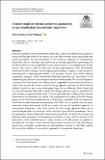A match made in heaven : predictive approaches to (an unorthodox) sensorimotor enactivism
Abstract
It has been pointed out that Sensorimotor Enactivism, a theory that claims that perception is enacted and brought about by movement, says very little about the neural mechanisms that enable perception. For the proponents of the predictive approach to Sensorimotor Enactivism, this is a challenge that can be met by introducing predictive processing into the picture. However, the compatibility between these theories is not straightforward. Firstly, because they seem to differ in their stand towards representations: while Sensorimotor Enactivism is said to belong to the non-representational wing of cognitive science, predictive processing has a representational profile. And secondly, because they exhibit different explanatory strategies: while Sensorimotor Enactivism prioritizes the interactions of the embodied agent, predictive processing has internalist commitments. The aim of this paper is to address these concerns and show that a predictive approach to Sensorimotor Enactivism is viable. More specifically, I focus on the Free-Energy approach, a theory that falls within the ballpark of predictive processing. In this paper I argue for the following claims. I argue that (a) both Sensorimotor Enactivism and the Free-Energy approach may be understood for some systems in representational terms. The non-representational reading of Sensorimotor Enactivism is not mandatory and neither is the representational reading of the Free-Energy approach. (b) Sensorimotor Enactivism is, in this respect, compatible with both representational and non-representational interpretations of the FEA. So, the position towards representations of these frameworks should not stand in the way of a predictive approach to Sensorimotor Enactivism. I also show that (c) the Free-Energy approach allows for an account that prioritizes the interaction of the embodied agent with the environment. This is the explanatory strategy followed by Sensorimotor Enactivism. To justify this strategy and following other proponents of Sensorimotor Enactivism, I argue that by referring to the interactions of the embodied agent a better account of the phenomena in question is provided. On this basis, I claim that (d) Sensorimotor Enactivism and the Free-Energy approach are compatible in what concerns their explanatory strategy as well. Thus, making the case for the viability of the predictive approach to Sensorimotor Enactivism.
Citation
Clavel Vázquez , M J 2019 , ' A match made in heaven : predictive approaches to (an unorthodox) sensorimotor enactivism ' , Phenomenology and the Cognitive Sciences , vol. First Online . https://doi.org/10.1007/s11097-019-09647-0
Publication
Phenomenology and the Cognitive Sciences
Status
Peer reviewed
ISSN
1568-7759Type
Journal article
Description
This work was supported by Mexico’s National Council of Science and Technology (Consejo Nacional de Ciencia y Tecnología, CONACYT) under PhD scholarship 295962/440722.Collections
Items in the St Andrews Research Repository are protected by copyright, with all rights reserved, unless otherwise indicated.

